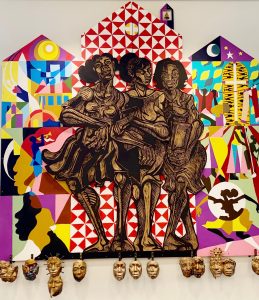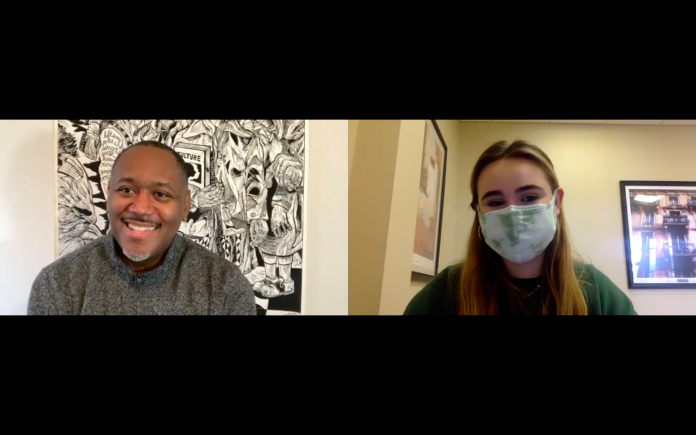In every correspondence, Steve Prince makes sure to sign off his emails with a simple yet effective “peace.” Prince is the Muscarelle Museum of Art’s director of engagement and distinguished artist-in-residence and has dedicated his entire career to cultivating and connecting with diverse communities through art and education. Apart from his impressive portfolio, Prince is an individual who perfectly personifies the intersection between passion and purpose.
“I’m doing what I’ve wanted to do since I was five,” Prince said. “I’ve done nothing outside of my field, I held no job that did not relate to art. Everything is art to me.”
One notable aspect about Prince is his adopted title of “art evangelist.” The term was first coined 10 years ago by Prince’s friend Phil Schaasfma. Prince made it clear that he embraces the term with the utmost humility. Similar to evangelists in the Bible, Prince’s unique approach to art takes the form of storytelling as a means of connecting with people, particularly when tackling themes of race, reconciliation and healing. His work presents a story that goes deeper than simply a picture, and he travels across the world to share the message within his art.
“I believe that my work, and the skills and the gifts that I have as an artist are inspired by God,” Prince said. “When I think about this idea of being an art evangelist, it is not something light and loose to say. It is something that I take very seriously and that is very much a part of and tied into who I am as a person. My care for community is exemplified by that title.”
“When I think about this idea of being an art evangelist, it is not something light and loose to say. It is something that I take very seriously and that is very much a part of and tied into who I am as a person. My care for community is exemplified by that title.”
In addition to his faith, much of Prince’s artistic inspiration stems from New Orleans, La., his hometown.
“There’s something about home, there’s something about the sounds, the smells, those things that go back to your earliest foundations of growing up,” Prince said. “I have not gone to any place that looks like New Orleans. There are places I’ve gone to that remind me of home, but no place is like the house I grew up in, or the yard in which I played.”
For Prince, New Orleans is packed with nostalgia, an idea many college students who are leaving home for the first time may understand.
As director of engagement, Prince oversees education outreach. He interacts with an array of people ranging from elementary schoolers to adults. Prince serves as a voice for the museum, drawing people in through education experiences, specifically around art and art making. For example, before our discussion, Prince spent the morning teaching a class in the business school on creative problem solving. The age of Zoom has allowed Prince greater access to education programs that extend outside the greater Williamsburg community.
“The beauty of Zoom is now I am international,” Prince said. “I get to go all over the place and teach to all different age brackets, it’s just I can’t look over the student’s shoulder and give them a one-on-one, but I try my best to create an authentic setting.”
One of Prince’s pieces is located on campus on the first floor of Early Gregg Swem Library. In 2017, Prince facilitated a one-month art program with 12 students ranging from 18 to 70 years old. The final piece entitled “Lemonade: A Picture of America” was produced for the 50th anniversary of the first African American residential students at the College.

“We were in Andrews for one month every day for four to five hours a day,” Prince said. “Students had a hand in every aspect of the mural”
On day one, Prince paired all the students in the class randomly with someone they didn’t know. They were then tasked with creating plaster masks of their partner’s face.
“I tried my best to create a space to say that not only is this class safe, but I will protect you and I won’t do anything that’s gonna hurt you to the best of my ability,” Prince said. “We all create an equal system of trust between each other.”
Prince explained that the greatest day came halfway through the program when the three women who were the first African American residential students at the College visited the studio and spoke with the participants. Each student then had the opportunity to assist in creating a plaster mask of them
“I sat the three women down on high chairs and every student touched the women’s faces and put a piece of plaster on,” Prince said. “We then took wax out of that and put it into molds and then poured bronze into that. The three masks on the bottom of the mural are their actual faces. We did no other manipulation”
All of the other masks present on the mural were a joint collaboration between the pairings made at the beginning of the program. The collaboration was in an effort to blend both participants’ stories together to tell a singular story.
“Now the partners are connected for life, their stories are shared in the making of that piece,” Prince said. “It’s the way of working together where we can break those barriers down and push past the stereotypes, that we can really cultivate a relationship that’s built on truth, beyond the surface of that mask.”
“their stories are shared in the making of that piece. It’s the way of working together where we can break those barriers down and push past the stereotypes, that we can really cultivate a relationship that’s built on truth, beyond the surface of that mask.”
Themes of reconciliation and healing also play prominent roles in Prince’s work. To commemorate the 400th anniversary of the first arrival of enslaved people in the United States at Point Comfort in Hampton, Va., Prince created the “Links” project which is on permanent display at the Sadler Center. This colossal piece is made up of puzzle pieces with a yellow chain link that runs down the middle of it. Prince worked with over 500 people over the course of six months from 20 countries. Each puzzle piece holds the name, location and age of every participant.
“We created about 30 workshops and each person made their individualized puzzle piece and then we brought all those pieces back together around that chain link motif which is a symbol of our inextricable connection,” Prince said.
The project culminated in a festival outside of the Sir Christopher Wren Building, where a steam roller was used to print the final image. All of those pieces were then brought back to the museum and were part of the show entitled “1619, 2019.” The Muscarelle then bought many of the pieces presented in the show. Prince explained that this was done in an effort “to further enrich the collection so that the collection is more reflective of the diversity of not only campus but the diversity of our nation.”
Prince is an artist in perpetual motion, and his work shows no signs of slowing down any time soon. As recently as this week, Prince assisted in launching a new project in association with the program “Cultural Arts Experience” led by the Greater Williamsburg Women’s Association. In a joint collaboration, Prince and the GWWA developed a project called “Art in a Box” for middle school students.
“We got together art supplies, information sheets on a few artists from the Museum’s collection,” Prince said. “We sent art supplies and information to the kids and asked them to make an art piece thinking about the stylistic working of those two artists while also thinking about making an original piece that speaks to these times that we’re going through right now.”
All of the pieces submitted were documented digitally and will be presented in a virtual exhibition through the Muscarelle Museum.
In addition to his work with the Muscarelle, Prince is also working on a personal project with his fiance entitled “Nine” which serves as a tribute to the Little Rock Nine. Prince is now preparing for a national tour that will travel to Richmond, San Antonio, Denver and New Orleans beginning in 2022.
In his closing thoughts, Prince presented advice for any young person who also wishes to pursue a career in the arts.
“First, do as much research as you possibly can about the field,” Prince said. “Secondly, it is about building community and finding people that are running along similar paths that you are. Those people can provide models for you to follow. What’s critical is not to try to be them. Your voice is cultivated by seeing, learning and mimicry. I also encourage practicing your craft, you can’t just talk about the work you have to do, you have to actually make it happen. The best teacher is practice. Then those doors and those opportunities will start popping open. When those doors open, do not be surprised, don’t go through the door believing you’re unqualified. Hurdle past the thoughts of self-doubt and then walk through the door when it opens, not with arrogance but with the confidence of knowing you’ll do the job well.”

